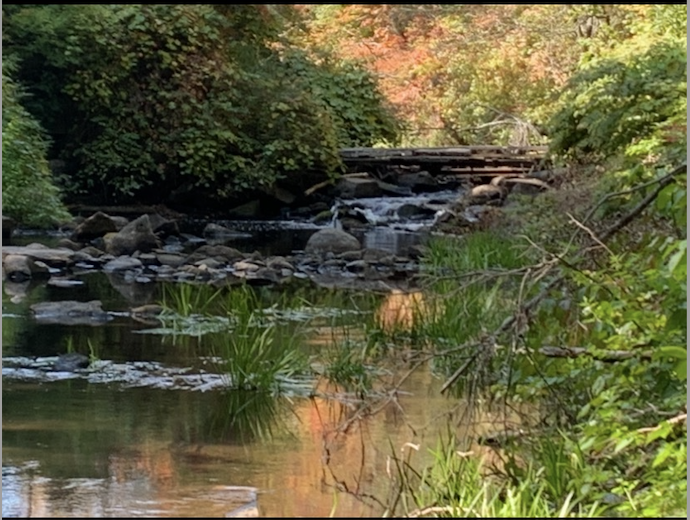I followed my mother down a winding forest path.
The trail head peaks through the trees that line the softball field down the street from my house. You wouldn’t know it was there if you weren’t looking for it.
Gnarled tree roots reach up from the soil, weaving across the path—the perfect snare for an imprecise step. Gusts of wind had recently plucked golden needles from the tops of the pines and littered them across the forest floor. Snags which once stood sentry along the trail now lay toppled over. We follow the path down toward the river, and I notice an old stone foundation over on the hillside. I wonder who might have lived there in the long-abandoned home. Who might have built it? The stones were laid with precision and care. I imagine a turn-of-the-century man claiming this fertile land by the river. Perhaps he had a farm here. I see him dab his brow as he labors in the sun, wiping dirtied hands on his overalls. His son brings him the final stone to be laid in the foundation. I picture this family and wish them well as I walk by the stones. This seemingly-ancient masonry is the only evidence that anyone ever lived on this land at all.
My mom and I cross the Charles on a haphazard bridge. It might have been a functioning bridge once, but it seems any effort to maintain it was abandoned long ago. Now it’s a sequence of overlapping wooden pallets, each of them exhibiting differing degrees of brokenness. On the other side, we cross seldom-used railroad tracks. There’s a sign nailed to a nearby tree. It reads “EPSTINE WAS MURDERED TO PROTECT PEDOS IN GOVERNMENT #BOOGALOO2020”
We climb up a hill, and my mom begins to give me her “tour.” She shows me where a “tornado” ripped trees up from their roots and tossed them about. “Must’ve been a micro burst or something, what else would explain that?” Moving along, we come across an enormous sandpit. I can imagine coming here in the wintertime, when the world is blanketed with snow, and sledding down the massive dunes. “This is an all-terrain tour! We’ve made it to the desert.” As we start to head home, she shows me the site of an annual fairy wedding, which, according to her, happens every March 15th. Trees circle a curious mound of earth in the center from which three slender trees grow. “The brides are sacrificed and buried right there in the middle—each year that pile gets bigger! Beware the Ides of March.” She has to look up where that phrase is from, but she thinks she used it appropriately.
It’s funny that my mother is leading me around these forgotten places in town. These are places that, fifteen years ago, I would have been disciplined for exploring. In fact, I had explored them as a child and played there often with my friends. I always felt guilty about it though, knowing I would get in trouble if my mom ever found out. That guilt kept me from exploring further than I would’ve liked. I’ve made up for it now, fifteen years later—with my mom.
Bellingham used to be a tourist town. Busy Bostonians bustled in from the city to lounge in humble cottages by the Charles. Back then, the river was wide and the current was strong. Visitors would glide down the water in their boats where it is now just a trickling stream.
They’re going to destroy these places, you know. Developer after developer has submitted applications before our Town board, eager to replace our forests with their housing developments—a lucrative endeavor. These are places I imagined I would bring my own daughter one day, or son, I suppose. They will live on only in my memory once they’re gone, and in the memories of those who once treasured them. The future residents, the future children, of Bellingham might never know the trails that sprawl through the forest. It makes me wonder—whose well-worn paths were erased to build my house?
